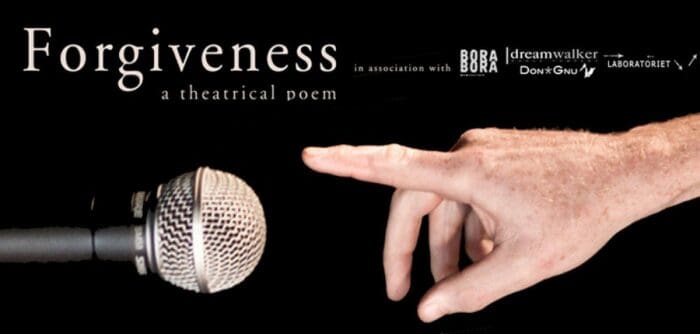 Forgiveness caught my attention the first moment I saw it because it wasn’t called a play, nor was it deemed to be a performance piece. It was called a “Theatrical Poem.” I wondered about how a theatrical poem would differ from theatre and/or from a poem. I must admit that I couldn’t make much of the distinction. To my mind, theatre and poetry have shared similar purposes. They use words to conjure images and evoke emotions in those who experience them. Theatre has some extra tools in its kit and, surely, there’s lots to be said for theatre that includes poetry, but really we’re talking about art whose content acts as a metaphor for the audience to digest. After having seen Forgiveness, my concept of a theatrical poem is no less murky. Writers Soheil Parsa, Barbara Simonsen, Peter Farbridge put together a script featuring a lot of dance elements and a fairly tech-heavy soundscape but they hardly ever go “beyond” what might be called ‘theatre’.
Forgiveness caught my attention the first moment I saw it because it wasn’t called a play, nor was it deemed to be a performance piece. It was called a “Theatrical Poem.” I wondered about how a theatrical poem would differ from theatre and/or from a poem. I must admit that I couldn’t make much of the distinction. To my mind, theatre and poetry have shared similar purposes. They use words to conjure images and evoke emotions in those who experience them. Theatre has some extra tools in its kit and, surely, there’s lots to be said for theatre that includes poetry, but really we’re talking about art whose content acts as a metaphor for the audience to digest. After having seen Forgiveness, my concept of a theatrical poem is no less murky. Writers Soheil Parsa, Barbara Simonsen, Peter Farbridge put together a script featuring a lot of dance elements and a fairly tech-heavy soundscape but they hardly ever go “beyond” what might be called ‘theatre’.
There wouldn’t be anything wrong with that if the theatre they presented was compelling. It was not. I was continually drawn out of the action by the repetitive nature of the movement in the show. Although the performers are clearly quite strong, and can complete interesting feats of strength both alone and in pairs, their actions didn’t seem to be particularly motivated by any character traits and, thus, lost poignancy.
One of the show’s significant shortcomings was its inability to create any sense of character. Sure, we got to see one woman act as a dancer, in front of the whole group for a while. The group spoke into microphones, she moved. Because the show was so episodic there was very little momentum to shape any character and, thus, even though a performer had danced alone for five minutes while the others spoke, there was never a moment where the dancer’s character was anything but ‘actor dancing on stage’.
Thomas Ryder Payne, Michelle Ramsay and Lindsay Anne Black deserve high praise for their work in sound, lighting and set design, respectively. The space, where so recently This Clement World was showing, had been completely transformed. The grunge replaced with purest white. Everything on the stage and in the theatre was clothed in a white, sheer covering, from floor to ceiling. Of course, lighting the space then became an interesting challenge for Ramsay who was able to use colour and darkness effectively to alter the mood on-stage. One of the central features of the set were dangling microphones, that flew up and down from the ceiling. They shaped the highlights of the play and the combination of excellent sound design and the aesthetic of dangling microphones in a white space coaxed some theatricality out of unlikely moments.
Forgiveness became a show with a couple of flashes of specific resonance while otherwise it was vague, dim poetry, with several droning monologues and consistent vignettes. The way that the microphones moved up and down, sometimes denying the right to speak seemed to become the meat of the show and, though it looked beautiful, it’s strange to go to a play where the most developed character is sitting off-stage, pulling on mic cords. In my opinion, Forgiveness should put the microphone-puller on the stage. At least, then, there’d be some theatre to watch.
